If you’re looking for the best dehumidifiers for your basement, I recommend considering units that match your space size and moisture needs. Models like the Waykar 80-Pint dehumidifier are great for large areas, while more compact options like the Vellgoo 52-Pint work for smaller spaces. Features like adjustable humidity control, silent operation, and continuous drainage help maintain a healthy environment. Keep in mind these top choices to find the perfect fit for your basement—more details follow.
Key Takeaways
- Select a dehumidifier with a capacity of 50-80 pints/day or higher for large basements over 4,000 sq ft.
- Ensure adjustable humidity controls between 30-80% for flexible moisture management.
- Opt for models with continuous drainage options to reduce manual tank emptying.
- Choose units with noise levels below 50 dB for quiet operation, especially in living or sleeping areas.
- Prioritize ENERGY STAR-certified dehumidifiers for efficient, eco-friendly moisture control.
Vellgoo 52 Pint/Day Dehumidifier with Drain Hose

Looking for a reliable dehumidifier that can handle large spaces like your basement? The Vellgoo 52 Pint/Day Dehumidifier is a great choice. It covers up to 4,500 sq.ft., making it perfect for basements, garages, or large rooms. It removes up to 52 pints of moisture daily and offers adjustable humidity from 40% to 80%. Its features include smart humidity control, auto shutoff, auto-restart, and a washable filter. It also comes with a drain hose, making continuous operation easy. Compact and portable at 34.2 pounds, it’s designed for efficiency, quiet operation, and eco-friendliness, earning ENERGY STAR Most Efficient 2024 certification.
Best For: homeowners with large spaces like basements, garages, or expansive rooms seeking efficient, quiet, and eco-friendly humidity control.
Pros:
- High coverage area of up to 4,500 sq.ft. with effective moisture removal of 52 pints daily
- ENERGY STAR Most Efficient 2024 certification ensures energy-saving operation and eco-friendliness
- Features include smart humidity control, auto shutoff, auto-restart, washable filter, and continuous drainage with a hose
Cons:
- Some users report compressor failure or unit malfunction after several months of use
- Durability concerns as units may stop functioning within a year, with limited long-term reliability
- Customer support can be inconsistent, with difficulty reaching assistance after warranty expires
Waykar 80 Pints Energy Star Dehumidifier
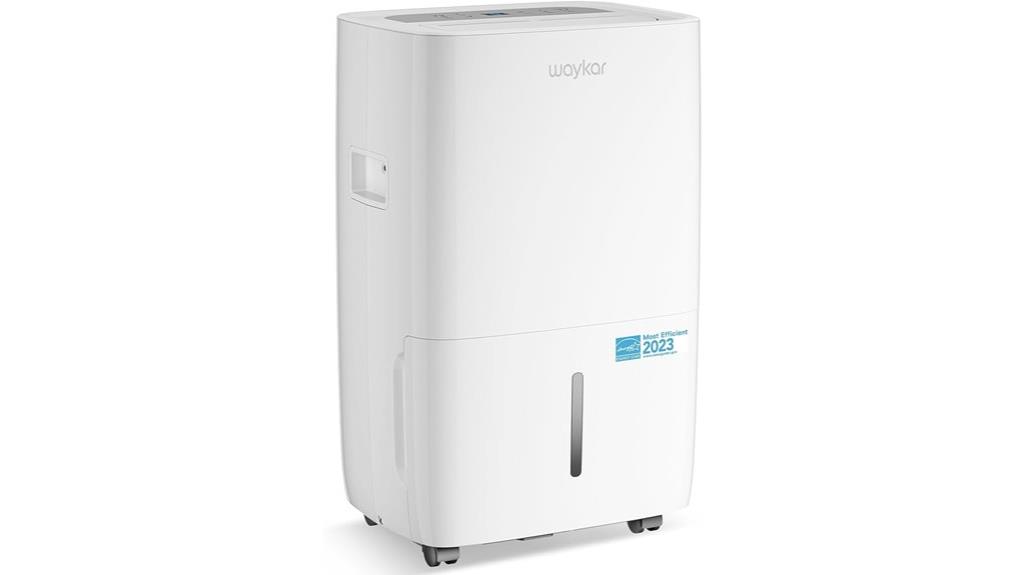
If you need a dehumidifier capable of handling large spaces, the Waykar 80 Pints Energy Star Dehumidifier is an excellent choice for your basement. It can cover up to 5,000 sq. ft. and removes up to 80 pints of moisture daily at 95°F, 90% RH. With adjustable humidity from 30% to 80%, it’s versatile for various areas like basements, bathrooms, and storage rooms. Certified as Energy Star compliant, it’s highly energy-efficient, reducing your bills. Its quiet operation at just 42 dB, along with smart controls and multiple drainage options, makes it easy to use and maintain. Plus, it’s backed by a 1-year warranty and reliable support.
Best For: homeowners and property managers seeking an energy-efficient, high-capacity dehumidifier for large spaces like basements, storage areas, or RVs.
Pros:
- Effectively covers up to 5,000 sq. ft. and removes up to 80 pints of moisture daily, ideal for large areas.
- Certified Energy Star compliance ensures higher energy efficiency, reducing long-term costs.
- Quiet operation at 42 dB and smart controls provide convenient, unobtrusive use.
Cons:
- Requires secure attachment of the continuous drainage hose to prevent leaks.
- Heavier and larger, which may be less portable for frequent movement.
- May be overpowered for small or enclosed spaces, leading to unnecessary energy use.
Waykar 80 Pints Energy Star Dehumidifier for Large Spaces
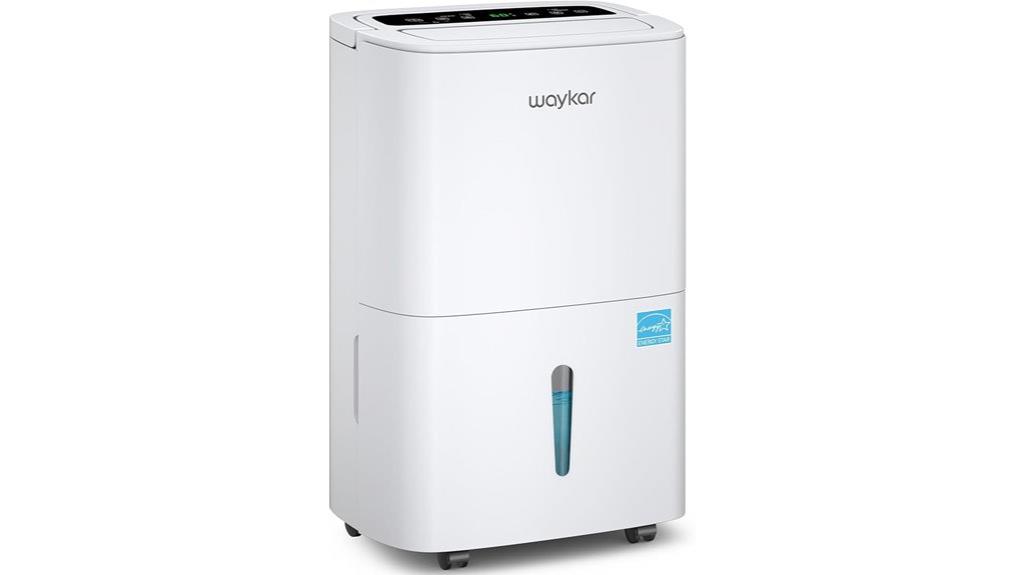
The Waykar 80 Pints Energy Star Dehumidifier is an excellent choice for large spaces like basements that need effective moisture control. It can remove up to 80 pints of moisture daily, making it suitable for areas up to 5,000 sq. ft. It features adjustable humidity from 30% to 80%, ensuring precise control. Certified Energy Star, it’s designed to save energy and reduce utility bills. The unit offers easy control via a touch panel, with features like auto-defrost, timer, and automatic humidity sensing. Its quiet operation, portability with casters, and dual drainage options make it practical for continuous use and maintenance.
Best For: those seeking an energy-efficient, quiet dehumidifier capable of managing large spaces up to 5,000 sq. ft., such as basements, large rooms, or commercial areas.
Pros:
- High moisture removal capacity of 80 pints per day, suitable for large spaces.
- Energy Star certified, promoting savings on utility bills with eco-friendly operation.
- Convenient features like touch control, auto-defrost, timer, and portable design with casters.
Cons:
- May require regular maintenance to clean the filter and empty the water tank.
- Continuous drainage setup can be slightly complicated for some users.
- Noise levels, although designed to be quiet, might still be noticeable in very quiet environments.
Smart Dehumidifier, 80 Pints Energy Star Dehumidifier for Large Rooms
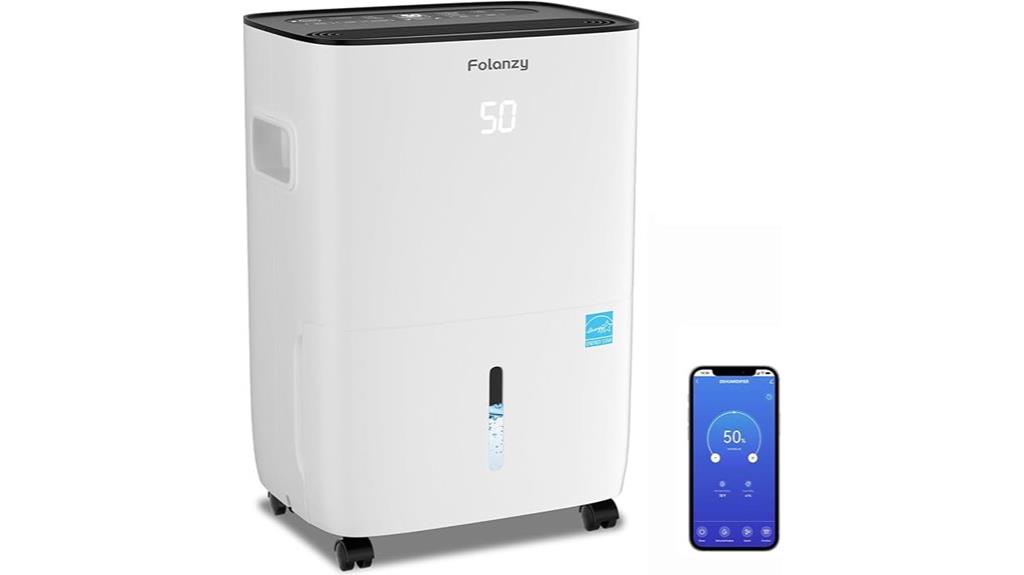
For large basements and spaces up to 5,200 square feet, the Smart Dehumidifier with an 80-pint capacity is an excellent choice, especially for those seeking convenient remote control and energy efficiency. It effectively removes up to 80 pints of moisture daily, quickly reducing humidity from 80% to 30%. Its large 1.14-gallon tank auto-shuts off when full, preventing leaks. The unit features a smart app for remote control, scheduling, and humidity adjustments, plus continuous drainage options. ENERGY STAR certified, it operates quietly while consuming around 275 watts, helping you save on utility bills. Its portability, durability, and user-friendly controls make it ideal for large, moisture-prone spaces.
Best For: homeowners and large space owners seeking an energy-efficient, smart-controlled dehumidifier to effectively manage humidity in spaces up to 5,200 sq. ft.
Pros:
- Equipped with smart app control for remote operation, scheduling, and humidity management
- Capable of removing up to 80 pints of moisture daily, suitable for large spaces and very humid environments
- ENERGY STAR certified, offering energy savings and quiet operation around 275 watts
Cons:
- Higher initial cost (~$300) compared to basic models
- Frequent filter alerts may require regular attention and maintenance
- Some users find the water drainage design could be improved for easier continuous drainage
VEAGASO 2500 Sq.Ft Dehumidifier with Drain Hose
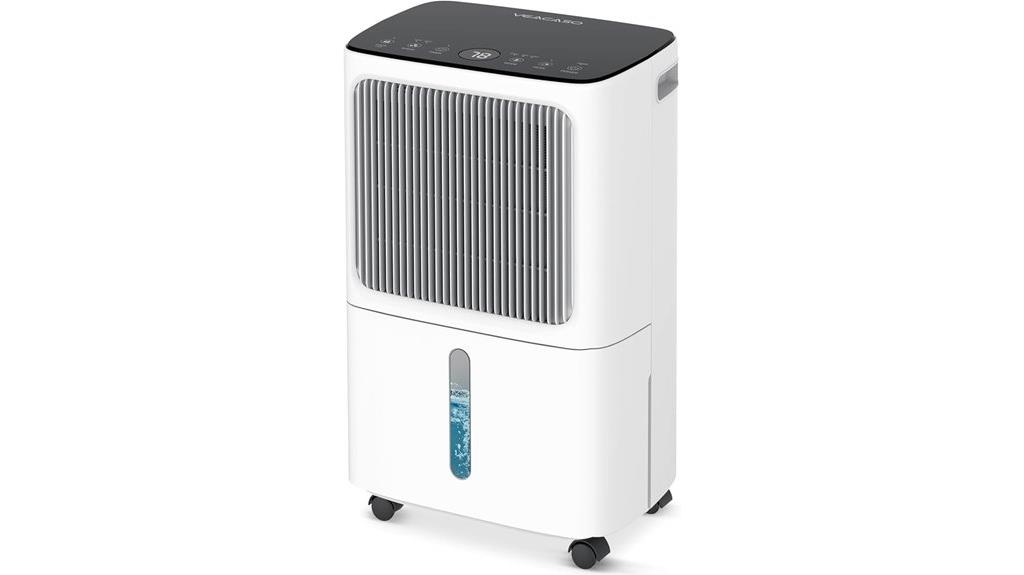
With its 2500 sq.ft capacity, the VEAGASO dehumidifier is an excellent choice for large spaces like basements, where high moisture levels can cause problems. It features three smart modes: DEHU for ideal humidity, DRY for quickly drying clothes, and CONT for continuous moisture management. The intelligent touchscreen makes adjusting humidity, timers, and fan speeds simple. It offers two drainage options—manual with auto-stop or continuous via the included hose—preventing overflow and reducing maintenance. With a max capacity of 34 pints per day, it keeps moisture in check effectively. Its sleek design, handle, and wheels make it portable and easy to use wherever needed.
Best For: those seeking an efficient, large-capacity dehumidifier to effectively manage moisture in big spaces such as basements, large bedrooms, or bathrooms.
Pros:
- Suitable for large areas up to 2500 sq.ft, providing comprehensive moisture control.
- Features three smart modes (DEHU, DRY, CONT) for tailored humidity and drying needs.
- Easy to operate with an intuitive touchscreen and convenient portability with handle and wheels.
Cons:
- May be bulkier and heavier compared to smaller dehumidifiers, requiring more space for mobility.
- Requires regular maintenance of the manual tank unless using continuous drainage, which may involve setup.
- Max dehumidification rate of 34 pints per day might be insufficient for extremely high-moisture environments.
Factors to Consider When Choosing Dehumidifiers for Basement
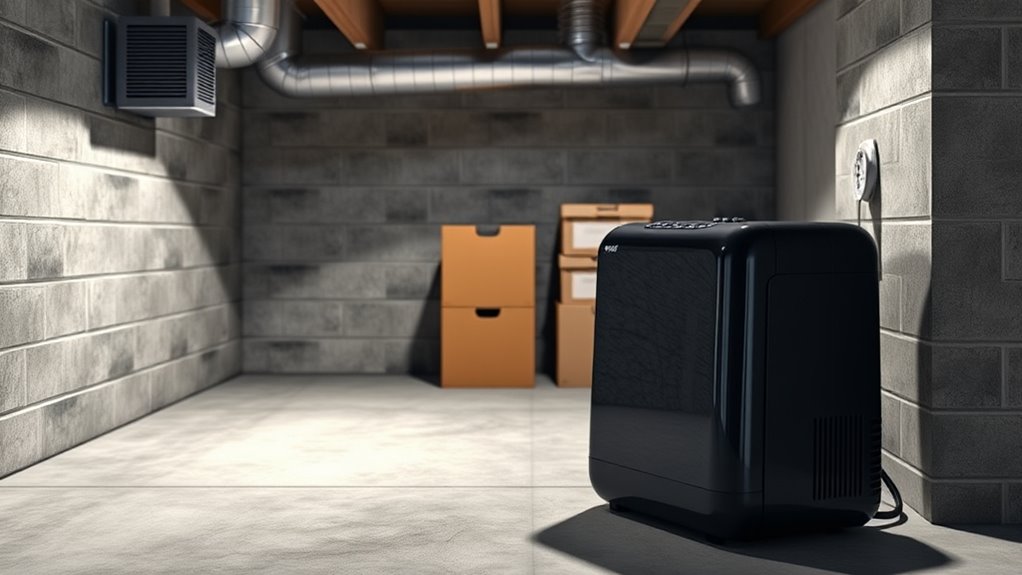
When choosing a dehumidifier for your basement, I look at several key factors to make certain it fits my needs. I consider the room size, humidity control options, and how it drains water, along with noise levels and energy use. These points help me pick a unit that’s effective, quiet, and efficient.
Room Size Compatibility
Choosing the right dehumidifier starts with understanding your basement’s size. I recommend checking the unit’s capacity and guaranteeing it matches your space. For larger basements, especially over 4,000 square feet, you’ll need a powerful unit that can remove 50-80 pints of moisture daily or consider commercial-grade options. Most dehumidifiers specify their effective coverage area in square footage—make sure this aligns with your basement’s size. Smaller or less powerful units may struggle in large or damp spaces, leading to ineffective moisture control. Proper sizing prevents the unit from overworking, which can shorten its lifespan and increase energy costs. To sum up, selecting a dehumidifier that fits your room size ensures ideal performance and efficient moisture removal.
Humidity Control Range
Selecting a dehumidifier that offers an appropriate humidity control range is vital for maintaining a healthy and comfortable basement environment. Ideally, look for units with an adjustable range between 30% and 80%, as this covers most moisture levels you’ll encounter. A wider range provides greater flexibility to adapt to seasonal changes or specific needs. If you want to prevent mold or protect sensitive items, a model capable of maintaining a set humidity level, like 50%, is ideal. Features like digital displays or precise controls make it easier to monitor and adjust settings accurately. Consistent humidity control helps prevent issues like dampness, mold growth, and musty odors, ensuring your basement stays dry, healthy, and comfortable year-round.
Drainage Options
Drainage options are a key factor to contemplate because they directly affect how much maintenance a dehumidifier requires and how seamlessly it operates. Units with continuous drainage allow you to connect a hose to an external water source, so you don’t have to empty the tank manually. This setup is ideal for long-term, hassle-free operation. Many models come with a drain hose adapter and garden hose connection, making permanent drainage straightforward. Auto shut-off features are also important—they prevent overflow by stopping the unit once the tank is full, adding safety and convenience. Properly securing the drain hose and ensuring tight connections are essential to prevent leaks and keep water flowing efficiently. Your choice depends on how much effort you want to spend on maintenance versus convenience.
Noise Levels
When considering how a dehumidifier will fit into your basement environment, noise levels are an important factor to keep in mind. Dehumidifiers produce sound measured in decibels (dB), with quieter models operating between 40-50 dB—about the volume of a quiet conversation. Many units designed for basements include noise-reduction features or sound-insulating materials to minimize disruption. Keep in mind that noise can vary depending on fan speed and compressor activity; lower speeds tend to be quieter but may reduce efficiency. Some models offer a “silent” or “quiet mode,” ideal for nighttime use or sensitive spaces. Customer reviews and product specs often list noise levels, so choosing a lower dB rating helps maintain a peaceful basement environment.
Energy Efficiency
Energy efficiency is a key factor to consider because it can considerably impact your long-term savings and environmental footprint. Look for dehumidifiers with ENERGY STAR certification, which meet strict standards for power use and eco-friendliness. Models with advanced refrigeration coils, compressors, and fans are designed to optimize energy consumption while still delivering strong performance. Features like auto mode, timers, and humidity sensors help prevent unnecessary operation, reducing electricity bills. Choosing a unit with lower wattage but high moisture removal capacity ensures effective dehumidification without wasting energy. Additionally, regular maintenance—such as cleaning filters and ensuring proper drainage—can boost your dehumidifier’s efficiency and lower overall energy consumption. Prioritizing energy-efficient models benefits both your wallet and the environment.
Portability Features
Choosing a dehumidifier with good portability features makes it much easier to manage your basement’s humidity without hassle. Look for units with built-in handles and wheels, which help you move the device smoothly across uneven floors or tight spaces. Lightweight models, around 30-35 pounds, are ideal for effortless repositioning. Compact dimensions—under 15 inches deep—allow the dehumidifier to fit through doorways and narrow pathways easily. Also, consider units with removable water tanks and drainage options, so you can empty or drain them quickly without lifting heavy containers. A long power cord and accessible storage help you place the dehumidifier near outlets and drainage points, enhancing flexibility. These features make maintaining *excellent* humidity levels more convenient and less physically demanding.
Durability and Warranty
Durability and warranty are essential factors to take into account because they directly influence how long your dehumidifier will perform reliably and how much protection you have against defects. A well-built model features high-quality materials, like corrosion-resistant coils and sturdy fans, which can withstand continuous use in a damp basement environment. A strong warranty, ideally at least a year full coverage plus extended protection for critical parts, indicates confidence in the product’s durability and helps protect your investment from manufacturing flaws. Longer warranties often mean fewer repair costs over time. While regular maintenance and prompt customer support are important, choosing a model with solid resilience and warranty coverage ensures dependable performance for years, minimizing unexpected expenses and replacements.
Ease of Maintenance
When selecting a dehumidifier for your basement, ease of maintenance should be a top priority. I recommend choosing units with washable or easily accessible filters, which make regular cleaning quick and simple. Look for models with clear indicator lights or alerts that notify you when the water tank is full or needs attention—this saves you from constant checks. Automatic shutoff features are also valuable, preventing overflow and reducing the need for constant monitoring. Simple control panels or remote app functionalities make operation and adjustments hassle-free. Finally, consider units built with durable materials and backed by reliable customer support, ensuring long-term performance and easy troubleshooting. Prioritizing these factors makes maintaining your dehumidifier straightforward, keeping your basement moisture-free with minimal effort.
Frequently Asked Questions
How Often Should I Drain or Empty My Dehumidifier?
You’re probably wondering how often to drain or empty your dehumidifier. I recommend checking the water collection tank regularly—at least once a week, especially in high humidity areas. If your dehumidifier has an auto-shutoff feature, it’ll turn off when full, making it even easier. Keep an eye on the tank, and empty it promptly to guarantee your device works efficiently and keeps your space dry.
Can I Leave a Dehumidifier Running Continuously in My Basement?
Sure, you can leave a dehumidifier running continuously in your basement, especially if moisture levels are high. I recommend setting it to maintain your desired humidity level rather than running it nonstop, to save energy and prevent over-drying. Just make sure your unit has an auto-shutoff feature or a drainage option, so it doesn’t overflow or waste power. Regular maintenance keeps it working efficiently, and your basement stays dry.
What’S the Ideal Humidity Level for Basements?
Oh, the irony—aiming for that perfect humidity level in your basement feels like chasing a ghost. I’ve found that keeping it between 50-60% usually does the trick. Anything lower, and you risk dry, cracking walls; higher, and mold becomes your unwanted guest. So, I suggest investing in a hygrometer and adjusting your dehumidifier accordingly. Trust me, your basement will thank you with no damp surprises.
How Noisy Are These Dehumidifiers During Operation?
You’re probably wondering how noisy these dehumidifiers are. In my experience, most operate quietly enough that I can work or relax nearby without distraction. Smaller models tend to be quieter, while larger, more powerful units might produce a bit more noise, but it’s usually still manageable. I recommend checking the decibel ratings of specific models—many manufacturers list this info—so you can choose one that suits your noise preferences.
Do Dehumidifiers Help Prevent Mold and Mildew Growth?
While mold and mildew seem harmless, they secretly damage your home and health. Dehumidifiers actively prevent this by reducing excess moisture, creating an environment where mold can’t thrive. I’ve seen firsthand how a good dehumidifier keeps my basement dry and mold-free, protecting my investment and well-being. Don’t wait for visible signs—using a dehumidifier is a smart step to prevent mold before it starts.
Conclusion
So, which dehumidifier will finally solve your basement moisture problem? The right choice depends on your space and needs, but one thing’s certain—ignoring the moisture could lead to bigger issues down the line. Ready to take control and keep your basement dry? Stay tuned, because choosing the perfect dehumidifier might just be the game-changer you’ve been waiting for. The secret to a dry, comfortable space is closer than you think.










